Voles (Microtus spp.) are small mammals that occur throughout Missouri. Commonly called meadow mice, they are distinguished from true mice by their short tails (about an inch long), stocky bodies and short legs. Their eyes are small and their ears are partially hidden. They are usually brown or gray but can vary in color.
Three species of voles occur in the state, the pine or woodland vole (Microtus pinetorum), the meadow vole (Microtus pennsylvanicus) and the prairie vole (Microtus ochrogatser). Voles are small, weighing 1 to 2 ounces as adults. Their overall body length varies from 3 to 5-1/2 inches in the pine vole, to about 4-1/2 to 7 inches in the meadow and prairie vole.
Voles serve as important food sources for many predators, including coyotes, hawks, owls, foxes and snakes. Mortality rates for voles are high. Life expectancy in the wild often does not exceed two months, and few live longer than 16 months. Not surprisingly, voles are prolific animals, although the pine vole is less so than meadow or prairie voles.
The breeding season for all voles encompasses most of the year although peaks occur in the spring and fall. Meadow and prairie voles normally have five to 10 litters per year and average three to five young per litter. Pine voles have one to six litters per year and average two to four young per litter.
Pine voles live in timbered areas, underground or in forest litter. They also inhabit fields surrounding timber if enough ground cover is present. Prairie and meadow voles inhabit pastures, roadsides, alfalfa fields and other grassy or weedy sites. Preferred habitats include areas with fairly dense ground vegetation. Meadow voles predominately occur in the northern portion of the state and are commonly found in low, moist areas or upland sites near water. Prairie voles are the most common species found throughout the state.
Meadow and prairie voles construct surface runways that are easy to recognize by the closely clipped vegetation within them. Small holes lead to underground runways and nesting areas. Pine voles have extensive underground runway systems, and spend little time above the leaf litter and ground cover layer.
These three vole species differ in color and size. However, it usually is not necessary to distinguish between the species to control the damage they cause. The exception may be for persons who have problems with pine voles. Because pine voles spend most of their time underground, control strategies may differ from those for meadow or prairie voles.
Many vole populations are cyclic. In North America, population peaks occur about every three to four years. These are not necessarily regular cycles, nor do they usually involve spectacular population explosions. Occasionally, population explosions last about a year before the population crashes. Several factors contribute to this potential for dramatic population increases: voles do not hibernate; females become reproductively active at a very young age (35 to 40 days); voles can give birth to a litter of three to six young every 21 days after the first litter. If the habitat provides protection from predators and high protein food sources exist, populations can reach devastating levels in a short period of time. Vegetation greater than 6 inches in height, snow cover, brush piles, leaves, and low-hanging limbs all provide excellent habitat protection. If there is good cover and high-quality food available during the growth period of the population, predators cannot keep up with the population growth and economic damage can occur.
Voles eat a variety of plants, such as grasses, legumes and crops (corn, soybeans, alfalfa, apples, wheat, potatoes and other vegetables). In horticultural plantings, including flower and shrub plantings, home orchards, lawns and gardens, voles can cause damage by eating flower bulbs, clipping grass stems, girdling stems of woody plants and gnawing roots. In late summer and fall, voles often store seeds, tubers, bulbs and rhizomes. In the winter they may gnaw on stems and bark, causing significant damage to ornamental and orchard plantings. Plants not directly killed may be more susceptible to diseases or die from water stress during periods of drought. Voles can also cause damage to newly planted crops, particularly in no-till crop production systems.
Voles also tend to live in colonies. A vole colony may have several den openings connected by a network of underground runways. The runs of the meadow and prairie voles are on the soil surface and lead to underground dens, while the runways of the pine vole are usually underground. Vole colonies consist of a pair of animals but more than likely will include several generations. A colony can have runways covering an area as large as a quarter acre.
Although voles have value in the natural world, homeowners and managers of valuable horticultural plantings may need to use measures to control damage from voles. This publication will help you identify voles and the damage they cause. Besides providing information on controlling vole populations to reduce damage, this publication also outlines early warning signs that you can use to prevent problems from becoming severe.
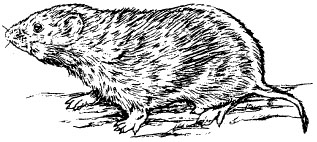 The prairie vole (Microtus ochrogaster).
The prairie vole (Microtus ochrogaster).
Characteristics of voles
Before initiating a vole control program, it is important to identify the species causing the damage. A brief description of the species' physical characteristics, reproduction and ecology follows. Meadow and prairie voles have similar behavioral and ecological characteristics and will be discussed together.
Integrated pest management for voles
Sound principles of integrated pest management (IPM) require that pest populations be monitored before any control measures are undertaken. Homeowners and managers of grounds with shrub and flower plantings can scout for vole colonies and runways, especially during the spring and fall. An apple sign test can be used to determine if voles are present. Control measures then can be restricted to those locations.
The apple sign test
The apple sign test was developed to monitor vole populations in commercial orchards. The test permits the grower to detect vole populations before damage becomes severe. It also encourages economy and reduces exposing nontarget animals to control activities. Because the test shows where control is needed, areas without voles are not treated, saving time and money and reducing environmental risk. For these reasons, anyone who has invested in ornamental landscaping or in commercial or home orchards should establish and maintain an apple sign test.
The apple sign test is easy to implement. The original method used 1-foot-square pieces of asphalt shingles placed throughout the orchard and particularly where old fields, woods and shrubs joined the orchard boundary. The gardener can use brown shingles that will blend in with the mulch or leaves. Sections of 1- to 2-inch-thick boards painted to match the background color of the flower garden or plantings can also be used.
- Step 1
Prepare enough of these shingles or wooden pieces to scatter them strategically along edges and throughout plantings at 15-foot intervals. In a commercial orchard, as many as 30 monitoring stations should be established per acre. These should be concentrated wherever woods and fields adjoin plantings, as well as scattered throughout large plantings. Sketch a map of the grounds, including the trees and shrubs in the area. This will serve as your recording sheet. - Step 2
To establish a test site, place a shingle on the ground, if possible over an entrance hole made by the vole. If you are monitoring for meadow or prairie voles, the shingle must be rounded in a tentlike fashion and propped up 3 to 4 inches off the ground so that the animal can go under it. In a commercial orchard, three rows of trees or shrubs should be identified and 10 monitoring stations should be placed per row about 30 to 40 feet apart. - Step 3
After five days, place a 1/2-inch cube of apple under each shingle. After 24 hours, observe whether the apple has been removed or eaten. On the map prepared in Step 1, indicate with + and - signs the presence or absence of voles. Leave the shingle in place for future monitoring. - Step 4
When monitoring has been completed, you can determine the locations where vole damage may occur and can direct control activities to those areas rather than treating the entire planting. - Step 5
File the recording sheets with the dates of monitoring and the locations at which control measures have been used. - Step 6
Conduct the apple sign test in the fall and spring each year and 21 to 30 days after each rodenticide application.
Trapping for positive identification
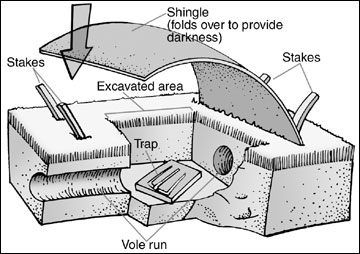 Excavate to place trap in vole run, then cover hole.
Excavate to place trap in vole run, then cover hole.
Trapping is also an effective way to determine the species of vole present. A snap-type mousetrap used with a small piece of apple for bait works well. A peanut butter-oatmeal bait also works well. The trap should be placed under the shingle. To trap pine voles, some excavation will be needed to place the trap down on the run. Place the trap at a right angle to the run. Bend the shingle to form an arched roof over the trap so that the spring will clear the shingle. (See above.)
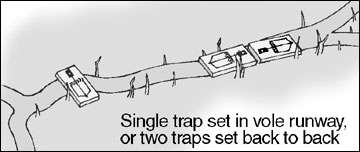 Place traps end to end or across the runway.
Place traps end to end or across the runway.
Prairie and meadow voles can be caught by setting traps at right angles to their runways or set back-to-back within the run. No excavation is needed because these species travel along surface runways. (See above.)
Controlling vole damage
Before initiating a vole control program, be sure to consider the extent of the problem in relation to the cost of control. Damage prevention is much more beneficial than population control after the damage has occurred.
Integrated pest management techniques include a combination of methods to prevent and control vole damage. Cultural practices, such as mowing, using herbicides to control competing vegetation, and frequent tillage can reduce the dense ground cover that serves as vole habitat. Although mulching with sawdust or wood chips is an important cultural practice for many ornamental plantings, remember this practice also provides habitat for voles. Good sanitation in the garden, orchard or lawn is also essential. Remove unused garden crops and clear all fruit from the orchard floor. Piles of dead branches and brush should be burned, chipped or hauled away to eliminate rodent habitat.
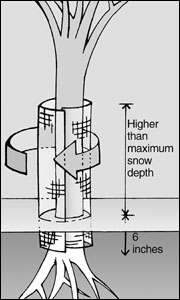 Protect young trees with cylinders of hardware cloth.
Protect young trees with cylinders of hardware cloth.
Young trees can be protected by placing cylinders made from hardware cloth mesh (1/4 inch or less) around the stems. Bury the hardware cloth about 6 inches deep to keep voles from burrowing under the wire cylinder and to reduce potential damage (Left). However, these exclusion techniques are not always practical, nor will they protect the stem in all situations.
Trapping can be used to eliminate small populations of voles and is often the most practical and economical method to use around the home and in the garden. As mentioned earlier, bait the mouse snap trap with a small slice of apple or with peanut butter-oatmeal bait. Be sure to stake the snap trap down, as a vole is strong enough to drag the trap away if not adequately caught.
Repellents
Various "thiram" and "hot sauce" repellents are registered for vole damage control on ornamental plants. They are not registered for use on gardens or plants intended for human consumption. Repellents are relatively expensive to use and, at best, provide only short-term protection. Precipitation often washes off the repellent and re-application through the year is often necessary. When foods are in short supply, as in the winter, the effectiveness of repellents usually decreases.
Using rodenticides in home landscapes
The reduction of large vole populations is accomplished most effectively with toxic baits. A good rodenticide program can be both effective and economical for home gardeners as well as commercial producers when vole damage is severe.
Home gardeners and managers of horticultural landscapes should consider using one of the labeled anticoagulant rodent baits to control voles. Anticoagulants require multiple feedings to kill the animal. These rodenticides are usually safer around nontarget species, and bait shyness will not develop as the animal never associates a weakened condition with the bait. Currently, chlorophacinone formulated as paraffinized pellets (sold as Rozol Rat and Mouse Bait Pellets) is recommended for use by homeowners and managers of horticultural landscapes for controlling voles. Be sure to read and follow all label directions when using any rodenticide.
Bait placement and use of bait stations. Place 2 tablespoons of pellets under a covered runway or in an entrance hole that is actively used by voles. Establish these covered bait stations at 10-foot intervals throughout the infested area. Placing these baits in protected areas will attract the rodent to the station, prevent ingestion by nontarget animals and minimize exposure to the weather.
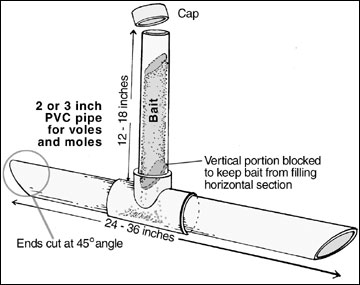 PVC pipe can be used to build a vole bait station.
PVC pipe can be used to build a vole bait station.
Bait stations can be made from 2- to 3- inch PVC pipe constructed in an L-shape or upside-down T-shape. (See above.) The horizontal pipe should be at least 12 inches long. Bait stations can also be made from rolled tar paper, mailing tubes, or similar durable materials.
After about five days, repeat the baiting. After another 21 days, conduct the apple sign test to confirm control. Repeat the baiting process only in those areas still showing vole activity.
Using rodenticides in commercial orchards
Managers of orchards and vineyards have other recommended rodenticide options to consider. One of the most successful rodenticide programs for use in orchards in Missouri uses two different rodenticides — one to provide a quick knockdown (a single-dose toxicant) and the other to provide protection throughout the winter (one of the anticoagulant baits).
Application of zinc phosphide. Zinc phosphide pelleted bait (such as Prozap Agri-brand or zinc phosphide Rodent Bait AG) is formulated at 2 percent active ingredient and may be placed in active vole runways or broadcast into vegetation with a mechanical spreader at 10 pounds per acre. It is labeled as a restricted-use pesticide and only be purchased and used only by a certified pesticide applicator. It is labeled for use as a broadcast application over grassy areas within an orchard to provide a quick knockdown of vole populations. Pellets are preferred because they are heavy enough to filter down through the thatch to get to the soil surface. This placement somewhat reduces the potential for nontarget exposure. However, zinc phosphide is acutely toxic to all vertebrates and therefore presents risks to nontarget wildlife in the orchard as well as safety risks to people. This product will normally eliminate existing populations of prairie and meadow voles within 72 hours and should be used when no rain or snow is forecast within 48 hours of the treatment. The apple sign test can be used to monitor vole activity and test the effectiveness of the treatment. After the vole population has been reduced with this treatment, an application of the anticoagulant bait chlorophacinone or diphacinone (Ramik Green) will control voles invading the orchard during the winter months.
Application of anticoagulant baits. Chlorophacinone and diphacinone are more toxic to rodents than to other mammals or birds, and when used according to label directions, the risk to nontarget wildlife from these products is minimal. Both are formulated at 0.005 percent active ingredient and are relatively safe when handled according to the label instructions. When placing by hand, select areas of vole activity and place the baits in the runways, such as under the shingles used for the apple sign test. For pine voles, the application rate for hand placement is 10 pounds per acre. A second application is recommended 20 to 30 days after the first. For mechanical broadcast applications, the rate is 20 pounds per acre. The pellets must be broadcast into vegetative cover, not on bare ground. For meadow or prairie vole control with diphacinone, the application rate for broadcast and hand placement is 10 pounds per acre.
Placement of commercially prepared baits. In an orchard, most vole activity is associated with green grasses. Meadow and prairie voles prefer the taller, clumping grasses such as fescue and orchard grass. Baits should be applied in the green grasses, not onto the bare ground. This is also true when treating for pine voles as they will come to the surface at night in the green vegetation to feed. If a herbicide strip is under the drip line of the trees or shrubs and there is a thatch present, the rodenticide should be applied in a band 3 to 4 feet wide on the edge of the green grass. Hand placement should be made in this same area.
Use of mechanical spreaders. All broadcast applications of commercially prepared baits should be made with mechanical spreaders. Several are available. An example is the Cyclone model M38400R, which can be tractor mounted. A mechanical spreader can be calibrated easily to distribute the pelleted rodenticide uniformly. All spreaders should be calibrated before use to ensure that the correct number of pounds of bait per treated acre will be spread. Calculate treated acreage as shown in the box above.
Remember
All rodenticides are designed to kill mammals. Take all reasonable precautions to prevent exposure to humans, pets, and nontarget mammals, birds and fish.
Recommendations for the use of agricultural chemicals are included in this publication as a convenience to the reader. Any mention or listing of commercial products or services in this publication does not imply endorsement by MU Extension nor discrimination against similar products not mentioned. Individuals who use agricultural chemicals are responsible for ensuring that the intended use complies with current regulations and conforms to the product label. Be sure to obtain current information about usage regulations and examine current product labels before applying any chemical. For assistance, contact your MU Extension center.